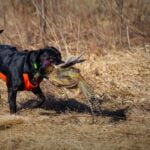Introduction
Controlling diabetes involves a great deal of self-management. It requires a person who has diabetes to monitor their blood sugar level throughout the day, which can be a challenging task if they are unable to accurately measure it themselves. Dogs have demonstrated an extraordinary ability to detect changes in glucose concentration and can be trained to alert a diabetic when their blood sugar level is too low or high. This article will provide detailed instructions on how to train your own dog to detect changes in blood sugar and act as an early warning system for diabetics.
1) Background Research: Before you start training your dog, it is important that you perform necessary background research. You need to understand something about diabetes and be aware of the signs and symptoms of low or high levels of glucose (blood sugar). Be sure you understand the implications for human health when glucose levels drop or climb too far outside the normal range. Additionally, read up on canine behavior so you can effectively communicate what you’re expecting from your pup during training sessions.
2) Reward System: Create a reward system that your pup will find appealing when they complete certain tasks correctly. Positive reinforcement during training is incredibly important as it helps build trust and encourages good behavior while also helping your dog learn quickly and effectively. Choose rewards that excite Fido but do not contain any elements that are likely to harm his health such as excess sugar or calories. Some examples include treats like peanut butter, sunflower seeds, slices of apple, or pieces of cooked egg whites – all foods with healthy properties that still offer a tasty reward for success!
3) Set Performance Goals: Establishing performance goals before each training session will help ensure that Fido is able to reach his full potential during training sessions and avoid frustration on both ends! Designate specific behaviors you expect from him such as sitting calmly next to someone’s hand when they are ready for him to smell their fingers for changes in glucose levels, barking once he smells something out of range, or shaking his paw once he’s successfully completed detection. Record each successful task accomplished by your pooch!
4) Repetition: The key element to successful dog training is repetition – read up on other methods relevant to sound techniques but simply repeating the same commands consistently will yield proven results over time! Utilize game-like scenarios to keep sessions interesting while simultaneously teaching your pup how serious this particular task is; make sure they learn how important it is without making them overwhelmed with guilt if they don’t get something correct right away. But no matter what type of game you choose, always end them with praise!
Knowing the Basics
Blood sugar, also known as glucose, is an important source of energy. It is the sugar that is produced in the body when carbohydrates are broken down and absorbed into the bloodstream. It helps to provide fuel for all the cells in the body, including muscles and organs. In order to maintain healthy levels of blood sugar, the pancreas releases a hormone called insulin which helps transport glucose into cells where it can be used as energy. Too much or too little blood sugar can lead to medical issues and need to be carefully monitored.
In order to train a dog to detect changes in blood sugar levels, it is important to understand how this process works and what triggers changes in glucose levels.
The pancreas releases insulin to regulate the amount of glucose present in the blood stream after eating or drinking something sugary or carbohydrate-heavy. At other times it produces glucagon which signals for more glucose production by releasing stored glycogen from liver and muscle cells into the bloodstream if glucose levels get too low. Insulin can cause low blood sugar (hypoglycemia) while glucagon spikes glucose levels (hyperglicemia). Dogs can be trained to recognize signs of both conditions by regularly exposing them and studying their response times.
Exercise has another significant effect on blood sugar levels as exercise increases insulin sensitivity which causes cells to use more available glucose leading to lower overall levels of circulating sugars in the bloodstream. A dog must learn how different exercises affect their human’s body and look out for early warning signs such as shakiness or dizziness caused by hypoglycemic episodes before they become too dangerous.
Finally, stress can cause hormonal changes which affect metabolic rate and lead to abrupt changes in blood sugar levels which could pose serious health risks for diabetics if not addressed quickly enough. Teaching a dog about stress triggers and ways its person can respond are an integral part of training so that they can take evasive actions should their human become ill due to sudden glucose level drops or elevation depending on individual needs.
Research and Reflection
Before beginning to train a dog to detect blood sugar levels, it is important that the trainer have an understanding of the behavior and skills needed for detection. Spend time researching how dogs can be trained for scent detection, familiarizing yourself with these concepts. Research methods of positive reinforcement training, such as clicker training and rewards-based systems. Consider the necessary steps in teaching a dog to associate a scent with a particular action or response. Think about the health needs of the dog; to ensure accuracy, trainers should make sure their canine companion receives regular checkups. Finally, take some time to reflect on your own abilities and strengths as a trainer before starting out.
Necessary Equipment
In order to properly train a dog to detect blood sugar, there are a few items of necessary equipment. Firstly, you will need treats; choose small, bite-sized rewards that your canine companion can easily snack on as a reward for accurately detecting drops and rises in your blood sugar levels. Secondly, you will need an accurate glucose monitor or meter. A meter contains separate test strips to measure an individual’s blood sugar level which should always be replaced after each use. Thirdly, you will need an extra long leash; this is needed during your training sessions as it allows you to keep your pup at a larger distance where he is still able to focus on learning the various commands associated with finding changes in your blood sugar levels. Finally, it is important to have a clicker or some other type of sound marker. This helps the dog differentiate between corrections and rewards. For example, if they respond correctly they will be rewarded with both verbal praise and the sound of clicking.
Creating the Right Environment
When training a dog to detect blood sugar, it’s important to create the right environment. This starts with establishing a positive learning space, free of distractions and full of positive reinforcement. It should be quiet and comfortable—but still entertaining enough to hold the dog’s attention. The space should also remain consistent, so that returning to it will remind them of their training sessions. You’ll want to provide plenty of treats and praise, too, which will help keep your dog motivated and eager to learn. Additionally, make sure the area is at a comfortable temperature for both yourself and your pup in order for activities to remain focused on the task at hand. With an inviting atmosphere created, you can set about teaching your canine companion what it needs to know!
The Training Process
Step 1: Start with introduction training and bonding. Introduce yourself to your dog and establish a trust bond by giving plenty of treats, toys, praise and love. This will set the groundwork to positively reinforce behaviors in the future and ensure that the two of you have a strong relationship.
Step 2: Begin scent training. Train your dog’s olfactory senses by exposing it to increasingly powerful scents like coffee grounds, essential oils, cotton balls soaked in water, etc. Allow them to investigate each scent slowly while rewarding them with treats when they indicate their interest with sniffing or pawing at the item. These sessions can be done either manually or through scented scent-bags.
Step 3: Introduce new scents related to blood glucose level monitoring devices, such as blood glucose test strips or lancets for testing blood samples. Reward your pup when it correctly matches a specific scent from one of these products by giving it its favorite toy or treat.
Step 4: Move onto simple tasks using these blood glucose detection materials. Give your dog commands such as “Find this” and hand an item containing the target odor (i.e., the test strip) for it to find through trial and error during playtime to begin associating its desired behaviors with the target odors directly related to diabetes monitoring equipment.
Step 5 Prepare for real world applications—Once your pet has mastered simple scent detection tasks you can start gently introducing more complex scenarios such as having your dog detect specific odors even after they’ve been placed in completely different environments than what they are used too; i.e., detecting diabetics’ scents on clothing or bedding items where appropriate environmental tests can be conducted safely outside in natural settings like parks and outdoor areas.. The majority of diabetes-related odor recognition relies heavily on room temperature condition differences so make sure you create those types of conditions during your homemade drills at home before heading out into public settings to practice with human volunteers who need assistance monitoring their diabetes .
The Power of Positive Reinforcement
Training a dog to detect low blood sugar levels in humans requires patience and consistency. Positive reinforcement is the most effective way to teach your dog this behavior, as it rewards the desired action or response and encourages them to repeat it in the future. The best way to employ positive reinforcement with your dog is through treats and verbal praise. Give your dog a treat each time they correctly demonstrate the desired behavior, such as correctly indicating when their human’s blood sugar is low. Verbally praising your dog for success can also reinforce positive behaviors and let them know that you are pleased with their performance.
It is also important to keep in mind that dogs can become uninterested quickly if their rewards system does not remain consistent. If you start giving smaller rewards after giving them larger rewards, your dog may become less motivated to learn or keep up good behaviors over time. To keep things interesting, try changing up your rewards system occasionally by transitioning from treats to fresh vegetables, fruit slices, playtime or even access to areas they don’t normally get access to- such as running around in the yard or spending extra time on walks. This will create an exciting element of surprise that will help motivate your pup every time they successfully detect changes in their human’s blood sugar levels. Additionally, if you want further ensure that your pup stays motivated, you can reward them frequently throughout training sessions so they stay focused and interested on the task at hand while avoiding any negative behaviors that could slow down the training process—such as barking or distractions from other parts of the home environment.
Troubleshooting Common Issues
When it comes to training a dog to detect blood sugar, there are common issues that can arise. The following tips will help you successfully overcome these obstacles:
• Start slowly. As with all types of training, give your dog time to adjust and establish a comfortable learning environment for them. Gradually increase task difficulty over time so your pup stays focused and engaged in the process.
• Use rewards-based methods throughout the entire process. Positive reinforcement is the key to teaching your pup effectively; engage in lots of praise, treats, and fun activities when they’re succeeding! This will go a long way towards building their confidence in the training process.
• Find appropriate ways to reduce stress if problematic behaviors emerge. If your pup appears stressed or overwhelmed by the process, take a step back and focus on bringing down their level of arousal before progressing further. This may mean reducing task difficulty or incorporating more breaks into the session; check with \a vet or animal behaviorist if necessary.
• Incorporate enzymatically active saliva detection strips as part of training sessions once your pup has mastered basic commands like sit, stay, and come. Regular use of these strips helps enforce healthy habits in dogs while also preparing them for actual blood sugar testing down the line.
• Do plenty of follow up practices as needed during and after successful detection days. Refreshing concepts every few weeks helps maintain your canine companion’s accuracy and allows for greater mastery over time!
Scouting for Success
Scouting your dog’s progress while they are in the process of learning how to detect blood sugar levels involves making sure that they are picking up on certain signs you give them. These signs can include things like a clap, cue words such as “seek”, or a verbal praise for correct behaviors. It is important to regularly reward your pup for correctly detecting low or high blood sugar levels with treats since this develops positive reinforcement and helps keep their focus on the task ahead. Additionally, it’s a good idea to start training your pup indoors in an environment that isn’t too distracting, then gradually work up to taking it outdoors where other distractions may exist. As they become more comfortable with their training, you can move onto higher intensity sessions of testing which will help better prepare them for the real-world scenarios that may come up when trying to detect blood sugar levels in people. Finally, make sure to take frequent breaks and provide praise and rewards during these transition periods so that your furry friend doesn’t become burned out!
Conclusion
When it comes to training your dog to detect blood sugar, there are several important points to consider. Firstly, make sure you establish a solid foundation of commands with your dog before introducing them to the smell and concept of blood sugar detection. Secondly, when you do introduce them, start with the lowest possible level of physical contact so that they become accustomed to the smell in a non-intimidating manner. Finally, be patient and consistent in reinforcing desired behavior; this is key for any successful training program.
Once these steps are followed, you will be on your way to having a reliable canine companion who can help remind you when it’s time to check your blood sugar levels! Remember: while all dogs may have the ability to detect changes in body chemistry, not all dogs are right for this type of task. Make sure you have adequate knowledge and resources before attempting to train an animal for medical service team. Lastly, ensure that your pup is getting enough attention, sleep and exercise – happy dogs make great detections!

Welcome to the blog! I am a professional dog trainer and have been working with dogs for many years. In this blog, I will be discussing various topics related to dog training, including tips, tricks, and advice. I hope you find this information helpful and informative. Thanks for reading!





